-
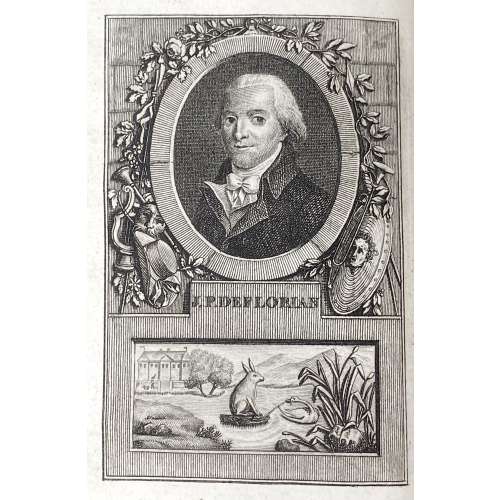 Title: FABLES | DE | M. DE FLORIAN , | de l’académie françoise, de celles de Madrid , | Florence, etc. | — | Je tâche d'y tourner le vice ridicule , | Ne pouvant l'attaquer avec des bras d'Hercule. | La Font. Fables , liv. V , I. — | [publisher's device ] | A PARIS, | DE L'IMPRIMERIE DE P. DIDOT L'AINÉ, | 1792. Pagination: ffl, [2 - h.t. / Imp.] [2 - blank / frontis.] [2 - tp. / blank] [5] 6-224 [2 - advert. / blank], bfl. Collation: numbered 1(5), 2-18(6), 19(3); engarved frontispiece portrait of Florian after François Hüet-Villiers, 5 engraved plates by Longueil, Delignon, and Gaucher after Flouest. Binding: Contemporary full mottled calf, all margins red, gilt floral ornaments to flat spine, red label with gilt lettering. Catalogue raisonné: Cohen, de Ricci 1912: p. 398-9.
Title: FABLES | DE | M. DE FLORIAN , | de l’académie françoise, de celles de Madrid , | Florence, etc. | — | Je tâche d'y tourner le vice ridicule , | Ne pouvant l'attaquer avec des bras d'Hercule. | La Font. Fables , liv. V , I. — | [publisher's device ] | A PARIS, | DE L'IMPRIMERIE DE P. DIDOT L'AINÉ, | 1792. Pagination: ffl, [2 - h.t. / Imp.] [2 - blank / frontis.] [2 - tp. / blank] [5] 6-224 [2 - advert. / blank], bfl. Collation: numbered 1(5), 2-18(6), 19(3); engarved frontispiece portrait of Florian after François Hüet-Villiers, 5 engraved plates by Longueil, Delignon, and Gaucher after Flouest. Binding: Contemporary full mottled calf, all margins red, gilt floral ornaments to flat spine, red label with gilt lettering. Catalogue raisonné: Cohen, de Ricci 1912: p. 398-9. -
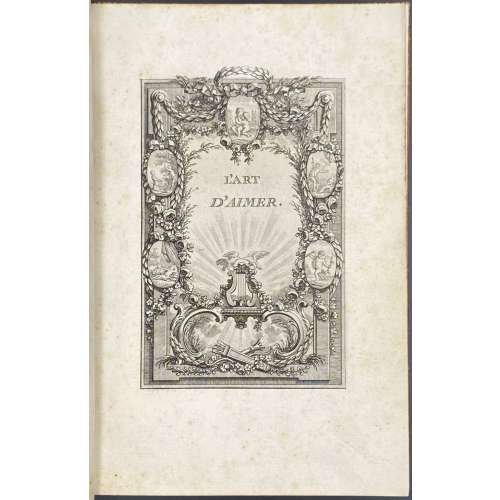 Title: L'ART | D'AIMER, | ET | POÉSIES DIVERSES | DE M. BERNARD. Pagination: [2] – t.p. / stanza by Voltaire; engraved t. p., frontispiece, [1] 2-170; pp. 1-61 – L'art d'aimer; pp. 62-111 – Phrosine et Mélidore; pp. 112-170 – Poésies diverses; illustrations. Collation: 8vo; π1 (letterpress t.p.), A-K8 L5; + 8 plates: (1)* engraved title page facing the stanza by Ch. Baquoy; (2) plate as a frontispiece by Ponce after Ch. Eisen, inscribed Chant I above the image, dated 1772, facing p. [1], chant 1er of l’art; (3)* Ch. Baquoy after P. Martini, inscribed Chant II below the image, facing p. 22, chant 2nd of l’art; (4) Ch. Baquoy after Eisen, inscribed Chant III above the image, facing p. 44, chant 3rd of l’art; (5)* Patas after P. Martini, inscribed Chant Ier below the image, dated 1775, facing p. 62, chant 1er of Phrosine; (6) Ch. Baquoy after Eisen, inscribed Chant II above the image, facing p. 74, chant 2nd of Phrosine; (7)* C. Gaucher after P. Martini, facing p. 84, chant 3rd of Phrosine; (8) Ch. Baquoy after Eisen, inscribed Chant IV above the image, facing p. 97, chant 4th of Phrosine; * – images additional to 1772 edition by Le Jay [LIB-2706.2021] (i.e. plates 1, 3, 5, and 7 are new). A counterfeit edition by an anonymous publisher. Binding: brown pebbled morocco, triple fillet gilt-ruled boards, raised bands, gilt in compartments, gilt label lettering to spine, marbled endpapers, AMG; printed on laid paper, with tall 's'. Catalogue raisonné: Cohen, De Richi (1912): p. 132: describes a counterfeit edition with 170 pages and 3 additional plates plus an engraved title. This seems to be a combination of Lejan [sic] Paris 1775 edition, which normally has 134 pages, 8vo, title engraved by Baquoy and three plates after Martini by Patas, Baquoy and Gaucher. Contributors: Nicolas Ponce (French, 1746 – 1831) – engraver. Jean Charles Baquoy (French, 1721 – 1777) – engraver. Jean-Baptiste Patas (French, 1748 – 1817) – engraver. Charles-Étienne Gaucher (French, 1740 – 1804) – engraver. Charles-Dominique-Joseph Eisen (French, 1720 – 1778) – artist. Pietro Antonio Martini (Italian, 1738 – 1797) – artist. Pierre-Joseph Bernard [Gentil-Bernard] (French, 1708 – 1775) – author of the text.
Title: L'ART | D'AIMER, | ET | POÉSIES DIVERSES | DE M. BERNARD. Pagination: [2] – t.p. / stanza by Voltaire; engraved t. p., frontispiece, [1] 2-170; pp. 1-61 – L'art d'aimer; pp. 62-111 – Phrosine et Mélidore; pp. 112-170 – Poésies diverses; illustrations. Collation: 8vo; π1 (letterpress t.p.), A-K8 L5; + 8 plates: (1)* engraved title page facing the stanza by Ch. Baquoy; (2) plate as a frontispiece by Ponce after Ch. Eisen, inscribed Chant I above the image, dated 1772, facing p. [1], chant 1er of l’art; (3)* Ch. Baquoy after P. Martini, inscribed Chant II below the image, facing p. 22, chant 2nd of l’art; (4) Ch. Baquoy after Eisen, inscribed Chant III above the image, facing p. 44, chant 3rd of l’art; (5)* Patas after P. Martini, inscribed Chant Ier below the image, dated 1775, facing p. 62, chant 1er of Phrosine; (6) Ch. Baquoy after Eisen, inscribed Chant II above the image, facing p. 74, chant 2nd of Phrosine; (7)* C. Gaucher after P. Martini, facing p. 84, chant 3rd of Phrosine; (8) Ch. Baquoy after Eisen, inscribed Chant IV above the image, facing p. 97, chant 4th of Phrosine; * – images additional to 1772 edition by Le Jay [LIB-2706.2021] (i.e. plates 1, 3, 5, and 7 are new). A counterfeit edition by an anonymous publisher. Binding: brown pebbled morocco, triple fillet gilt-ruled boards, raised bands, gilt in compartments, gilt label lettering to spine, marbled endpapers, AMG; printed on laid paper, with tall 's'. Catalogue raisonné: Cohen, De Richi (1912): p. 132: describes a counterfeit edition with 170 pages and 3 additional plates plus an engraved title. This seems to be a combination of Lejan [sic] Paris 1775 edition, which normally has 134 pages, 8vo, title engraved by Baquoy and three plates after Martini by Patas, Baquoy and Gaucher. Contributors: Nicolas Ponce (French, 1746 – 1831) – engraver. Jean Charles Baquoy (French, 1721 – 1777) – engraver. Jean-Baptiste Patas (French, 1748 – 1817) – engraver. Charles-Étienne Gaucher (French, 1740 – 1804) – engraver. Charles-Dominique-Joseph Eisen (French, 1720 – 1778) – artist. Pietro Antonio Martini (Italian, 1738 – 1797) – artist. Pierre-Joseph Bernard [Gentil-Bernard] (French, 1708 – 1775) – author of the text. -
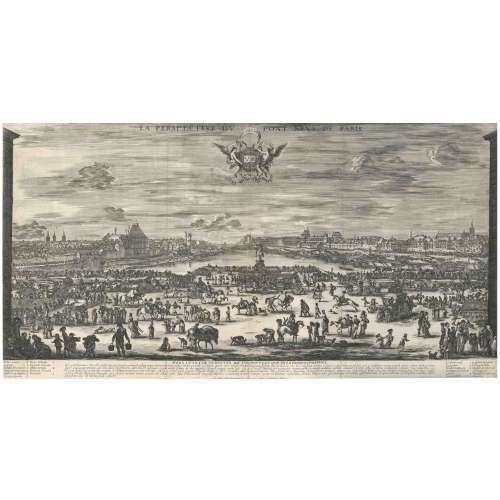
Etching on laid paper, backed. Massar (1971): 59-61. View of the Pont Neuf in Paris, with the statue of Henry IV at centre in front of the Seine, the church of St.-Germaine l'Auxerrois and the Louvre to the right, and the Hôtel de Nevers and Tour de Nesle to the left (MET). in the banner below: LUDOVICO XIIII GALLIARUM ET NAV REGI; below image: PONS LVTETIÆ STRVCTVS, DICTVS NOVVS, ET QVÆ EX EO PROSPICI POSSVNT.; bellow: En pulcherrimus toto ... caufatus, vifere; along the bottom: Ste. Della Bella Florentinus In. e Fecit DD. 1646. Cum Privilegio Regis; additional lettering a lower left and right identifying places depicted.
State: 2nd, with the weathercock on the belltower of Église Saint-Germain l'Auxerrois (under 8). Size: 35.5 x 67.6 cm. Condition: Three vertical folds, these partly cracked and backed at the bottom, dusty or slightly stained, partly slightly rubbed, a small diagonal crease on the upper left, tiny marginal blemishes.Quotation from Phyllis D. Massar. Presenting Stefano della Bella. — NY: The Metropolitan Museum of Art, [1971]: "For size and complexity, one of Della Bella's most impressive achievements is his view of Paris across the Pont Neuf from a point between the buildings bounding the Place Dauphine. Besides the well-known landmarks-the Hộtel de Nevers, the Tour de Nesle, the church of Saint Germain l'Auxerrois, and, at the centre, the bronze equestrian statue of Henri IV by the Florentines Giovanni Bologna and Pietro Tacca – the print provides a microcosm of Paris in transit across the Seine. With a glass, one can compile a census of 451 people, thirty-eight horses, nineteen dogs, three donkeys, and one lamb. All but lost in the vast scene, nevertheless, all contributing to it, are duelists, men fighting with staffs, brawlers routing passers-by, a tooth-puller making an extraction, sellers of sweetmeats and fruits, falconers, hunters with a pack of dogs, a legless cripple, many begging gypsies (one of them telling a fortune), and a hurdy-gurdy player with an audience. Moving among the splendid carriages is a humble water cart, and back among the market stands at the right is an early Seine-side bookstall."
Catalogue raisonné: Massar (1971): pp. 58-61; De Vesme p. 132, № 850ii/ii. Contributor: Stefano della Bella (Italian, 1610 – 1664) – artist and engraver. -
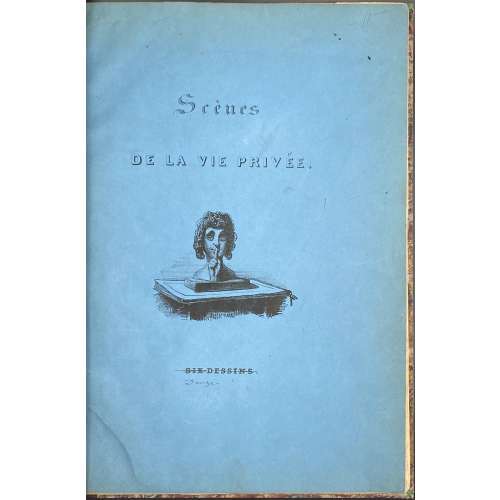 Pictorial album 31 x 22.8 cm, bound in quarter red calf over marbled boards with gilt lettering “SCÈNES | DE | LA VIE | PRIVÉE” and gilt ornament to spine; marbled endpapers, flyleaf, blue original wrapper (title-page) lettered SCÈNES | DE LA VIE PRIVÉE. | {vignette} | SIX DESSINS || «Six dessins» struck out, ms inscription beneath “Douze”. Twelve hand-coloured lithographs, some inscribed with letters and/or numbers in reverse, each in a double-rule frame 22 x 16.5 cm, images 18 x 14.5 cm (approx.); series title “Scènes de la vie intime” printed above the frame, image title printed in the lower compartment; ms numbers above the upper-right corner of the frame (state before sequential numbers, ms numbers do not correspond with artist numbering). Flyleaf at the end. Two bookplates to front pastedown: “EX-LIBRIS PAUL GAVAULT” and armorial “IN ROBORE ROBUR | Ex Libris Bourlon de Rouvre”. Content (Roman numerals in parenthesis are publisher's numbers; numerals in italic are Armelhault-Bocher reference numbers):
Pictorial album 31 x 22.8 cm, bound in quarter red calf over marbled boards with gilt lettering “SCÈNES | DE | LA VIE | PRIVÉE” and gilt ornament to spine; marbled endpapers, flyleaf, blue original wrapper (title-page) lettered SCÈNES | DE LA VIE PRIVÉE. | {vignette} | SIX DESSINS || «Six dessins» struck out, ms inscription beneath “Douze”. Twelve hand-coloured lithographs, some inscribed with letters and/or numbers in reverse, each in a double-rule frame 22 x 16.5 cm, images 18 x 14.5 cm (approx.); series title “Scènes de la vie intime” printed above the frame, image title printed in the lower compartment; ms numbers above the upper-right corner of the frame (state before sequential numbers, ms numbers do not correspond with artist numbering). Flyleaf at the end. Two bookplates to front pastedown: “EX-LIBRIS PAUL GAVAULT” and armorial “IN ROBORE ROBUR | Ex Libris Bourlon de Rouvre”. Content (Roman numerals in parenthesis are publisher's numbers; numerals in italic are Armelhault-Bocher reference numbers):- Titre de la couverture (Title-page) – 2001
- (III) Un nid dans les blés (A nest in the wheat) – 2004
- (II) Amitié de pension (Friendship in the pension) – 2003
- (XI) Bras dessus, bras dessous (Arm up, arm down) – 2012
- (I) Causerie (Chat) – 2002
- (VI) Prélude (Prelude) – 2007
- (IX) Le guet-apens (Ambush) – 2010
- (V) Le cabinet noir (The dark chamber) – 2006
- (IV) Distraction (Entertainment) – 2005
- (X) Leçon de paysage (Landscape lesson) – 2011
- (VII) Avant le péché (Before sin) – 2008
- (VIII) Après le péché (After sin) – 2009
- (XII) La femme du peintre (The painter's wife) – 2013
-
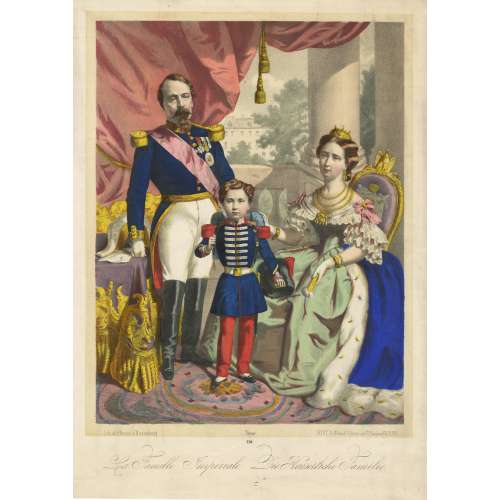 Hand-coloured lithography on wove paper, 395 x 280 mm; black ink stamp “5309” to reverse. On image: artist's initials "L. H."; on stone: "Lith. de Fr. Wentzel a Wissembourg. — Déposé — DÉPÔT, Fr. Wentzel Editeur rue St. Jacques 65, PARIS"; below centre: "239"; bottom : La famille Impériale. Die Kaizerliche Familie. Napoleon III [Charles-Louis Napoléon Bonaparte] (French, 1808 – 1873) Eugénie de Montijo [L'impératrice Eugénie] (Spanish-French, 1826 – 1920) Napoléon, Prince Imperial (Napoléon Eugène Louis Jean Joseph Bonaparte] (French, 1856 – 1879) Jean Frédéric Wentzel (French, 1807 – 1869) – publisher/printer.
Hand-coloured lithography on wove paper, 395 x 280 mm; black ink stamp “5309” to reverse. On image: artist's initials "L. H."; on stone: "Lith. de Fr. Wentzel a Wissembourg. — Déposé — DÉPÔT, Fr. Wentzel Editeur rue St. Jacques 65, PARIS"; below centre: "239"; bottom : La famille Impériale. Die Kaizerliche Familie. Napoleon III [Charles-Louis Napoléon Bonaparte] (French, 1808 – 1873) Eugénie de Montijo [L'impératrice Eugénie] (Spanish-French, 1826 – 1920) Napoléon, Prince Imperial (Napoléon Eugène Louis Jean Joseph Bonaparte] (French, 1856 – 1879) Jean Frédéric Wentzel (French, 1807 – 1869) – publisher/printer. -
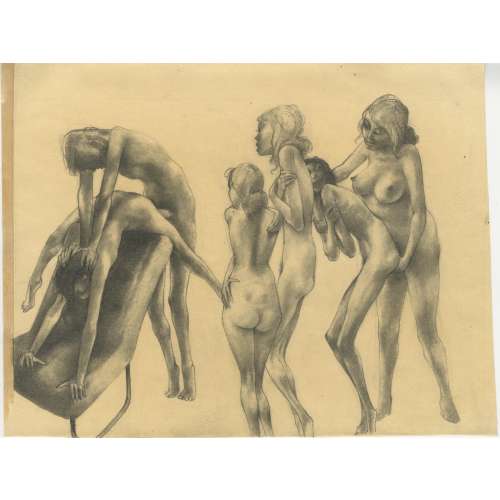 Graphite on wove paper, 217 x 284 mm, black ink stamp to verso: “Prof O. R. Schatz | Wien II, Gr. Mohreng 3b | Tel.: 55 82 566”. Unsigned, attributed to Otto Rudolf Schatz (Austrian, 1900 – 1961).
Graphite on wove paper, 217 x 284 mm, black ink stamp to verso: “Prof O. R. Schatz | Wien II, Gr. Mohreng 3b | Tel.: 55 82 566”. Unsigned, attributed to Otto Rudolf Schatz (Austrian, 1900 – 1961). -
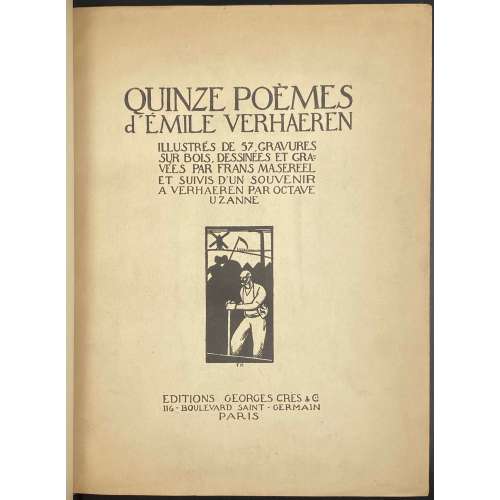 Quinze poèmes d'Emile Verhaeren. Illustrés de 57 gravures sur bois dessinées et gravées par Frans Masereel et suivis d'un 'Souvenir à Verhaeren' par Octave Uzanne. — Paris: Éditions Georges Crès, 1917. Authors: Emile Verhaeren (text), Frans Masereel (illustrations), Octave Uzanne (text). Publisher: Éditions Georges Crès. [Georges-Célestin Crès (1875 - 1935) was a French publisher and bookseller. Address: 116 boulevard Saint-Germain, Paris]. Printer: Sonor S.A. - Geneve, under the direction of Auguste Jordanis. The number of copies printed: 1555 of which 15 (1-15) on Japan paper, 190 (16-205) on Fabriano paper, and 1350 (206-1555) on English paper (1506-1555 not for trade). This copy № 1312. Pagination: [i] - front cover, [ii] - half-title, [iii] - title, [iv] - printrun justification, [v] - table of contents, [vi] - blank, [i-vii] viii-ciii, [civ] - printer statement, [cv] - back cover; one-side (recto) printing and pagination. Owner's contemporary red half-Morocco with marbled boards; spine with four raised bands, gilt lettering and design elements. Original printed paper wrappers preserved. Marbled endpapers. Trimmed unevenly.
Quinze poèmes d'Emile Verhaeren. Illustrés de 57 gravures sur bois dessinées et gravées par Frans Masereel et suivis d'un 'Souvenir à Verhaeren' par Octave Uzanne. — Paris: Éditions Georges Crès, 1917. Authors: Emile Verhaeren (text), Frans Masereel (illustrations), Octave Uzanne (text). Publisher: Éditions Georges Crès. [Georges-Célestin Crès (1875 - 1935) was a French publisher and bookseller. Address: 116 boulevard Saint-Germain, Paris]. Printer: Sonor S.A. - Geneve, under the direction of Auguste Jordanis. The number of copies printed: 1555 of which 15 (1-15) on Japan paper, 190 (16-205) on Fabriano paper, and 1350 (206-1555) on English paper (1506-1555 not for trade). This copy № 1312. Pagination: [i] - front cover, [ii] - half-title, [iii] - title, [iv] - printrun justification, [v] - table of contents, [vi] - blank, [i-vii] viii-ciii, [civ] - printer statement, [cv] - back cover; one-side (recto) printing and pagination. Owner's contemporary red half-Morocco with marbled boards; spine with four raised bands, gilt lettering and design elements. Original printed paper wrappers preserved. Marbled endpapers. Trimmed unevenly. -
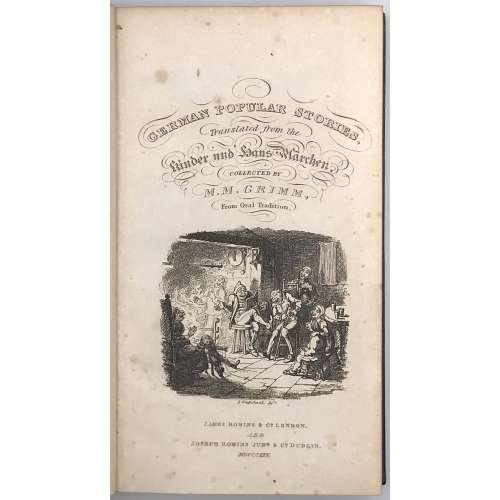 A two-volume set. Volume 1: GERMAN POPULAR STORIES | translated from the | Kinder und Haus Märchen, | COLLECTED BY | M. M. GRIMM, | from oral tradition. | [Vignette] | JAMES ROBINS & Co. LONDON. |AND | JOSEPH ROBINS JUNR & Co. DUBLIN. | MDCCCXXV.|| 12mo, pp. xii, 240; engraved title vignette and 11 plates by George Cruikshank, with a fine proof (?) of the plate illustrating ‘The Jew in the bush’ on India paper laid onto verso of leaf bound between half-title and title. Table of contents: Hans in luck -- The travelling musicians -- The golden bird -- The fisherman and his wife -- The tom-tit and the bear -- The twelve dancing princesses -- Rose-bud -- Tom thumb -- The grateful beasts -- Jorinda and Jorindel -- The waggish musician -- The queen bee -- The dog and the sparrow -- Frederick and Catherine -- The three children of fortune -- King grisly-beard -- The adventures of chanticleer and partlet -- Snow-drop -- The elves and the shoemaker -- The turnip -- Old sultan -- The lady and the lion -- The jew in the bush -- The king of the golden mountain -- The golden goose -- Mrs. fox -- Hansel and Grettel -- The giant with the three golden hairs -- The frog prince -- The fox and the horse -- Rumpel-stilts-kin.; Volume 2: GERMAN POPULAR STORIES | translated from the | Kinder und Haus Märchen, | COLLECTED BY | M. M. GRIMM, | from oral tradition. | [Vignette] | JAMES ROBINS & Co. LONDON. |AND | JOSEPH ROBINS JUNR & Co. DUBLIN. | MDCCCXXVI.|| 12mo, iv, 256, [2]; engraved title vignette and 9 plates by George Cruikshank. Table of contents: The goose-girl -- Faithful John -- The blue light -- Ashputtel -- The young giant and the tailor -- The crows and the soldier -- Pee-wit -- Hans and his wife Grettel -- Cherry, or the frog-bride -- Mother Holle -- The water of life -- Peter the goatherd -- The four clever brothers -- The elfin-grove -- The salad -- The nose -- The five servants -- Cat-skin -- The robber-bridegroom -- The three sluggards -- The seven ravens -- Roland and may-bird -- The mouse, the bird, and the sausage -- The juniper tree. Binding: bound without advertisements in 19th-century brown morocco by Leighton, spines decorated and lettered in gilt, gilt edges, marbled endpapers; armorial bookplates of Thomas Gaisford and Charles Tennant to endpapers. Note: The third edition of vol. 1 (first C. Baldwyn 1823) and the first edition of vol. 2 of the first English translation of Grimm’s Fairy Tales – including Tom Thumb, the Elves and the Shoemaker, Hansel and Grettel, the Frog Prince, and Rumpelstiltskin – with George Cruikshank’s celebrated illustrations. Of Cruikshank’s work, Ruskin remarked, ‘The etchings are the finest things, next to Rembrandt’s, that, as far as I know, has been done since etching was invented. You cannot look at them too much, nor copy them too often’ (The Elements of Drawing, 1857). Provenance: (1) Thomas Gaisford (1779-1855), classical scholar, Regius Professor of Greek at Oxford University, Dean of Christ Church, curator of the Bodleian Library and delegate of the Clarendon Press. (2) Sir Charles Tennant, 1st Baronet (1823-1906), a Scottish industrialist who amassed a notable library and collection of pictures at his Peeblesshire estate, ‘The Glen’. Catalogue raisonné: Albert M. Cohn 369.
A two-volume set. Volume 1: GERMAN POPULAR STORIES | translated from the | Kinder und Haus Märchen, | COLLECTED BY | M. M. GRIMM, | from oral tradition. | [Vignette] | JAMES ROBINS & Co. LONDON. |AND | JOSEPH ROBINS JUNR & Co. DUBLIN. | MDCCCXXV.|| 12mo, pp. xii, 240; engraved title vignette and 11 plates by George Cruikshank, with a fine proof (?) of the plate illustrating ‘The Jew in the bush’ on India paper laid onto verso of leaf bound between half-title and title. Table of contents: Hans in luck -- The travelling musicians -- The golden bird -- The fisherman and his wife -- The tom-tit and the bear -- The twelve dancing princesses -- Rose-bud -- Tom thumb -- The grateful beasts -- Jorinda and Jorindel -- The waggish musician -- The queen bee -- The dog and the sparrow -- Frederick and Catherine -- The three children of fortune -- King grisly-beard -- The adventures of chanticleer and partlet -- Snow-drop -- The elves and the shoemaker -- The turnip -- Old sultan -- The lady and the lion -- The jew in the bush -- The king of the golden mountain -- The golden goose -- Mrs. fox -- Hansel and Grettel -- The giant with the three golden hairs -- The frog prince -- The fox and the horse -- Rumpel-stilts-kin.; Volume 2: GERMAN POPULAR STORIES | translated from the | Kinder und Haus Märchen, | COLLECTED BY | M. M. GRIMM, | from oral tradition. | [Vignette] | JAMES ROBINS & Co. LONDON. |AND | JOSEPH ROBINS JUNR & Co. DUBLIN. | MDCCCXXVI.|| 12mo, iv, 256, [2]; engraved title vignette and 9 plates by George Cruikshank. Table of contents: The goose-girl -- Faithful John -- The blue light -- Ashputtel -- The young giant and the tailor -- The crows and the soldier -- Pee-wit -- Hans and his wife Grettel -- Cherry, or the frog-bride -- Mother Holle -- The water of life -- Peter the goatherd -- The four clever brothers -- The elfin-grove -- The salad -- The nose -- The five servants -- Cat-skin -- The robber-bridegroom -- The three sluggards -- The seven ravens -- Roland and may-bird -- The mouse, the bird, and the sausage -- The juniper tree. Binding: bound without advertisements in 19th-century brown morocco by Leighton, spines decorated and lettered in gilt, gilt edges, marbled endpapers; armorial bookplates of Thomas Gaisford and Charles Tennant to endpapers. Note: The third edition of vol. 1 (first C. Baldwyn 1823) and the first edition of vol. 2 of the first English translation of Grimm’s Fairy Tales – including Tom Thumb, the Elves and the Shoemaker, Hansel and Grettel, the Frog Prince, and Rumpelstiltskin – with George Cruikshank’s celebrated illustrations. Of Cruikshank’s work, Ruskin remarked, ‘The etchings are the finest things, next to Rembrandt’s, that, as far as I know, has been done since etching was invented. You cannot look at them too much, nor copy them too often’ (The Elements of Drawing, 1857). Provenance: (1) Thomas Gaisford (1779-1855), classical scholar, Regius Professor of Greek at Oxford University, Dean of Christ Church, curator of the Bodleian Library and delegate of the Clarendon Press. (2) Sir Charles Tennant, 1st Baronet (1823-1906), a Scottish industrialist who amassed a notable library and collection of pictures at his Peeblesshire estate, ‘The Glen’. Catalogue raisonné: Albert M. Cohn 369. -
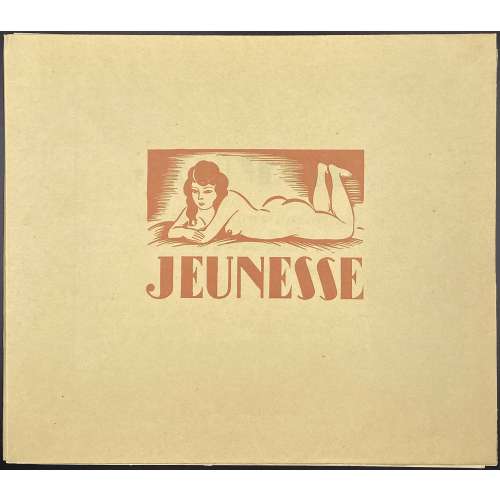 12 hand-coloured soft-ground etchings by André Collot, unbound, in a paper folder with pink lettering and vignette engraved on wood, with a title-page in black: JEUNESSE | 12 VERNIS MOUS COLORIÉS | tires à exemplaires | réservés aux Amis de l’Artiste | 1933 ||, in a frame. Edition: 1st edition, limited to 60 copies. Catalogue raisonné: Dutel 1920-70: 1786. There is another copy of the same with the cardboard folder SVE-0528.2023.
12 hand-coloured soft-ground etchings by André Collot, unbound, in a paper folder with pink lettering and vignette engraved on wood, with a title-page in black: JEUNESSE | 12 VERNIS MOUS COLORIÉS | tires à exemplaires | réservés aux Amis de l’Artiste | 1933 ||, in a frame. Edition: 1st edition, limited to 60 copies. Catalogue raisonné: Dutel 1920-70: 1786. There is another copy of the same with the cardboard folder SVE-0528.2023. -
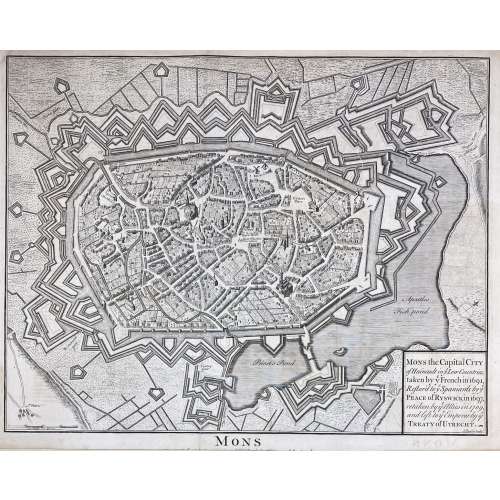
Mons the Capital City of Hainault in y Low Countries, taken by y French in 1691, Restor'd to y Spaniards by y Peace of Ryswick in 1697, retaken by y Allies in 1709, and left to y Emperor by y Treaty of Utrecht. attribution to publication source has been trimmed.
Dimensions: Sheet: 40.7 x 52.5 cm; Image: 37.5 x 48 cm. Published between 1744 and 1747. Attribution to publication source has been trimmed. Reference: Royal Academy 03/2919. Source: Maps for Mr. Tindal's Continuation of Mr. Rapin's History of England. London: John and Paul Knapton. Nicolas Tindal (British, 1687 – 1774) – the translator and continuer of the History of England by Paul de Rapin. Paul de Rapin (French, 1661 – 1725) – a Huguenot historian, author of the History of England. -
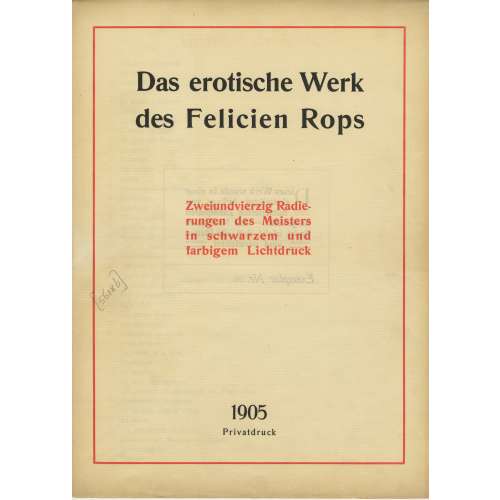
A limited-edition (№26/500) set of 42 etchings and drypoints after Félicien Rops (Belgian, 1833 – 1898), each mounted in a numbered passe-partout, printed posthumously by an anonym in Germany in 1905; in a flapped half faux suede-backed cardboard portfolio with straps, 442 x 335 mm, red embossed lettering to the front cover, bookplate of Richard Teschner (Austrian, 1879 – 1948) pasted inside.
Title-page (in a red frame): Das erotische Werk | des Felicien Rops | Zweiundvierzig Radie- | rungen des Meisters | in schwarzem und | farbigem Lichtdruck | 1905 | Privatdruk ||
Limitation (in a red two-section frame) : Dieses Werk wurde in einer | einmaligen Auflage von | 500 numerierten Exemplaren | hergestellt. — Ein Nachdruck | findet nicht statt, die Platten | == sind vernichtet == | Exemplar Nr. 26 ||
Verzeichnis der Tafeln (Table of Contents): 1. Initiation sentimentale; 2. La croix; 3. Entre-acte; 4. Holocauste; 5. La bonne hollandaise; 6. Étude; 7. La femme au pantin; 8. L’amour de Satan; 9. Au pays des féminies; 10. La volupté; 11. Evocation; 12. De castitate; 13. Joujou; 14. Vengeance d’une femme; 15. Phantasies; 16. Indolence; 17. Théâtre gaillard; 18. Appel au peuple; 19. Masques modernes; 20. Tout est grand chez les rois; 21. Marie-Madeleine; 22. L’amante du Christ; 23. Feuille de vigne; 24. La messe de Guide; 25 Viol et prostitution; 26. Le maillot; 27. Les jeunes France; 28. Les diaboliques; 29. Coquetterie au miroir; 30. Jeune homme; 31. La femme et la mort; 32. Confidence; 33. La bergère; 34. La mère aux satyrions; 35. Les exercices de dévotion de Mr. Henri Roch; 36. Mademoiselle de Maupin; 37. Le bonheur dans le crime; 38. La sirène; 39. Les cabotinages de l’amour; 40. Document sur l’impuissance d’aimer; 41. A cœur perdu; 42. Curieuse.
-
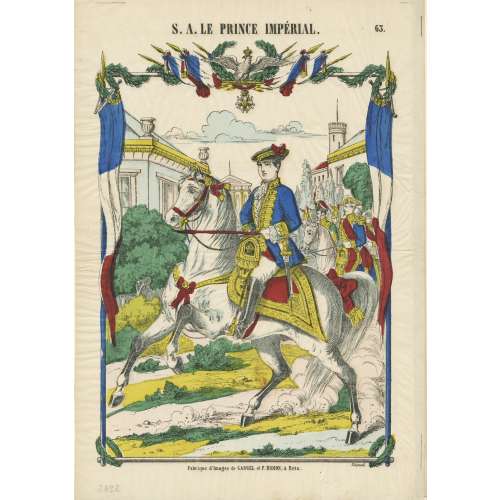 Hand-coloured woodcut on wove paper, 327 x 280 mm; black ink stamp “5265” to reverse, attached to the sheet 470 x 325 mm. Top centre: "S. A. LE PRINCE IMPÉRIAL.", right: "63." Image: equestiral portrait of Prince Impérial. Under the image, centre: "Fabrique d'Images de GANGEL et P. DIDION, à Metz." — "Déposé." Napoléon, Prince Imperial (Napoléon Eugène Louis Jean Joseph Bonaparte] (French, 1856 – 1879). Gangel et P. Didion (Metz); Paulin Didion (French, 1831 – 1879) – publisher/printer.
Hand-coloured woodcut on wove paper, 327 x 280 mm; black ink stamp “5265” to reverse, attached to the sheet 470 x 325 mm. Top centre: "S. A. LE PRINCE IMPÉRIAL.", right: "63." Image: equestiral portrait of Prince Impérial. Under the image, centre: "Fabrique d'Images de GANGEL et P. DIDION, à Metz." — "Déposé." Napoléon, Prince Imperial (Napoléon Eugène Louis Jean Joseph Bonaparte] (French, 1856 – 1879). Gangel et P. Didion (Metz); Paulin Didion (French, 1831 – 1879) – publisher/printer. -
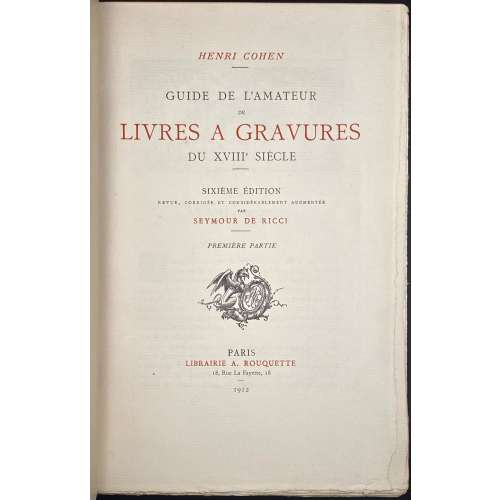 Herni Cohen. Guide de l'amateur de livres à gravures du XVIIIe siècle (6e édition) / Revue, corrigée et considérablement augmentée par Seymour de Ricci, préface par R. Portalis; 2 Volumes. – Paris: Librairie A. Rouquette, 1912. – Achevé d'Imprimer à Melun par Émile Legrand le 25 juin MDCCCCXII [1912]. Vol. 1, Première partie – ABAA-LUY: ffl [4 blanks] [2 - orig. grey front wrapper w/title, verso blank] [2 blanks] [2 - ht, tirage] [2 - blank, frontis. w/protect. sheet] [2 - blank, frontis. w/protect. sheet] (double frontis. - correct), [2 - t.p., blank] [i - avant-propos w/vignette] ii-vi, [vii - préface w/vignette] viii-xxvi; [1-2 - Tome 1, I] 2-668 (two numbers per page), [2 - fin, blank] [2 blanks] [2 - orig. grey back wrapper, recto blank] [orig. spine strip] [4 blanks] bfl. Vol. 2, Seconde partie – MAB-ZUR : ffl [4 blanks] [2 - orig. grey front wrapper w/title, verso blank] [2 blanks] [2 - ht, blank] [2 - t.p., blank] [2 - blank, frontis. w/protect. sheet] [2 - blank, frontis. w/protect. sheet] (double frontis. - correct), [1-2 - Tome II, 22] 671-1248 (two numbers per page), [2 - printer, blank] [2 blanks] [2 - orig. grey back wrapper, recto imprim.] [orig. spine strip] [4 blanks] bfl. Size: Super Royal 8vo, 26.2 x 17.2 x 5.1 cm. Binding: Contemporary blue half morocco over marbled boards, marbled end-papers, top margin gilt, gilt lettering to spine (title, owner: P. R.).; bookplate pasted to verso of the first blank leaf: " Ex Libris R. Decamps Scrive." – for bibliophile René Descamps-Scrive (French, 1853 –1924). Original wrappers preserved. Printed on Hollande paper, copy № 2 of the first 50; total print-run 1050 copies. Catalogue raisonné of French illustrated books of the 18th century.
Herni Cohen. Guide de l'amateur de livres à gravures du XVIIIe siècle (6e édition) / Revue, corrigée et considérablement augmentée par Seymour de Ricci, préface par R. Portalis; 2 Volumes. – Paris: Librairie A. Rouquette, 1912. – Achevé d'Imprimer à Melun par Émile Legrand le 25 juin MDCCCCXII [1912]. Vol. 1, Première partie – ABAA-LUY: ffl [4 blanks] [2 - orig. grey front wrapper w/title, verso blank] [2 blanks] [2 - ht, tirage] [2 - blank, frontis. w/protect. sheet] [2 - blank, frontis. w/protect. sheet] (double frontis. - correct), [2 - t.p., blank] [i - avant-propos w/vignette] ii-vi, [vii - préface w/vignette] viii-xxvi; [1-2 - Tome 1, I] 2-668 (two numbers per page), [2 - fin, blank] [2 blanks] [2 - orig. grey back wrapper, recto blank] [orig. spine strip] [4 blanks] bfl. Vol. 2, Seconde partie – MAB-ZUR : ffl [4 blanks] [2 - orig. grey front wrapper w/title, verso blank] [2 blanks] [2 - ht, blank] [2 - t.p., blank] [2 - blank, frontis. w/protect. sheet] [2 - blank, frontis. w/protect. sheet] (double frontis. - correct), [1-2 - Tome II, 22] 671-1248 (two numbers per page), [2 - printer, blank] [2 blanks] [2 - orig. grey back wrapper, recto imprim.] [orig. spine strip] [4 blanks] bfl. Size: Super Royal 8vo, 26.2 x 17.2 x 5.1 cm. Binding: Contemporary blue half morocco over marbled boards, marbled end-papers, top margin gilt, gilt lettering to spine (title, owner: P. R.).; bookplate pasted to verso of the first blank leaf: " Ex Libris R. Decamps Scrive." – for bibliophile René Descamps-Scrive (French, 1853 –1924). Original wrappers preserved. Printed on Hollande paper, copy № 2 of the first 50; total print-run 1050 copies. Catalogue raisonné of French illustrated books of the 18th century. -
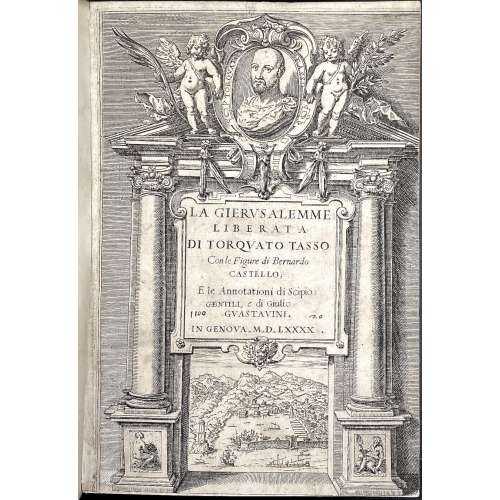 Engraved title with the portrait of Torquato Tasso, displayed in an oval medallion, bound in “TORQUATO TASSO”, between two naked putti; Architecture with two columns and Ionic capitals supporting an architectural pediment; between the columns is a table with the inscription: LA GIERVSALEMME | LIBERATA | DI TORQVATO TASSO | Con le Figure di Bernardo | CASTELLO; | E le Annotazioni di Scipio | GENTILI, e di Giulio | GVASTAVINI. | IN GENOVA. M.D.LXXXX .|| Contents: The 20 cantos are followed by: Tutte le stanza intere, che dall'autore sono state refiutate in questo libro; Annotationi di Scipio Gentili; Luoghi osservati dal mag. Giulio Guastavini, quali il Tasso nella sua Gierusalemme hà presi & imitati da poeti & altri scrittori antichi; Allegoria del poema; Tavola di tutti i nomi proprii et di tutte le materie principali contenute nel presente libro. Pagination: [2] engraved t.p. / blank, 3-11, [1] 2-255 [256], 1-71 [72] [1] 2-40, 4 unpag. leaves ‘Allegoria del poema’; total 387 pp. Collation: 8vo; π6 A-Q8 A-D8 E4 A-B8 χ4 (in the first quire M4 marked L4), ills. signed in collation. At p. 17 canto 3rd marked as 2nd, pp. 135 and 139 in 12th canto marked as 11th. Binding: later full polished calf, blind double-ruled covers, blind double-ruled raised bands, gilt lettering: GIERVSALEMME | LIBERATA and GENOVA | 1590. TMG. Printed on laid paper. Front joints split at head and tail. Title page and twenty full-page ill. facing the opening of each canto, engraved by Agostino Carracci and Giacomo Franco after Castello. Those for cantos 6-8, 10, 12, 16-17, 19-20 are by Carracci, 8 and 19 with his initials. The remainder are by Franco and are signed by him. Woodcut head and tailpieces, the Argomenti at the head of each canto within cartouches, initials. Catalogue raisonné: Adam Bartsch. Le peintre graveur. — Vienne: J. V. Degen, 1803.
Engraved title with the portrait of Torquato Tasso, displayed in an oval medallion, bound in “TORQUATO TASSO”, between two naked putti; Architecture with two columns and Ionic capitals supporting an architectural pediment; between the columns is a table with the inscription: LA GIERVSALEMME | LIBERATA | DI TORQVATO TASSO | Con le Figure di Bernardo | CASTELLO; | E le Annotazioni di Scipio | GENTILI, e di Giulio | GVASTAVINI. | IN GENOVA. M.D.LXXXX .|| Contents: The 20 cantos are followed by: Tutte le stanza intere, che dall'autore sono state refiutate in questo libro; Annotationi di Scipio Gentili; Luoghi osservati dal mag. Giulio Guastavini, quali il Tasso nella sua Gierusalemme hà presi & imitati da poeti & altri scrittori antichi; Allegoria del poema; Tavola di tutti i nomi proprii et di tutte le materie principali contenute nel presente libro. Pagination: [2] engraved t.p. / blank, 3-11, [1] 2-255 [256], 1-71 [72] [1] 2-40, 4 unpag. leaves ‘Allegoria del poema’; total 387 pp. Collation: 8vo; π6 A-Q8 A-D8 E4 A-B8 χ4 (in the first quire M4 marked L4), ills. signed in collation. At p. 17 canto 3rd marked as 2nd, pp. 135 and 139 in 12th canto marked as 11th. Binding: later full polished calf, blind double-ruled covers, blind double-ruled raised bands, gilt lettering: GIERVSALEMME | LIBERATA and GENOVA | 1590. TMG. Printed on laid paper. Front joints split at head and tail. Title page and twenty full-page ill. facing the opening of each canto, engraved by Agostino Carracci and Giacomo Franco after Castello. Those for cantos 6-8, 10, 12, 16-17, 19-20 are by Carracci, 8 and 19 with his initials. The remainder are by Franco and are signed by him. Woodcut head and tailpieces, the Argomenti at the head of each canto within cartouches, initials. Catalogue raisonné: Adam Bartsch. Le peintre graveur. — Vienne: J. V. Degen, 1803.Author: Written by Torquato Tasso (Italian, Sorrento 1544–1595 Rome)
Designer: Illustrations designed by Bernardo Castello (Italian, Genoa (?) 1557–1629 Genoa)
Engraver: Illustrations engraved by Agostino Carracci (Italian, Bologna 1557–1602 Parma)
Engraver: Illustrations engraved by Giacomo Franco (Italian, Venice 1550–1620 Venice)
Publisher: Published by Girolamo Bartoli , Genoa
Ref.: MET, HathiTrust, -
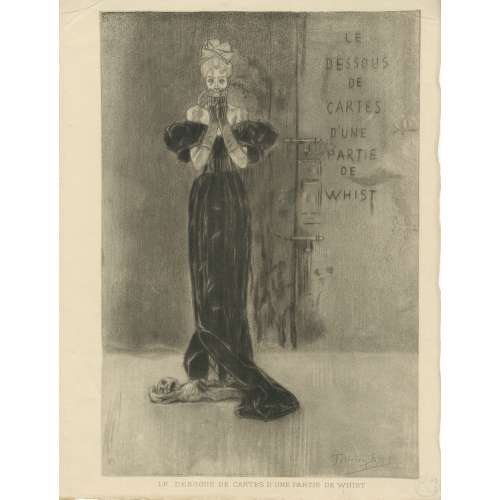
Soft-ground etching on laid paper. Inscribed on plate: "Le dessous de cartes d'une partie de whist" [The underside of a game of whist]. Owner's stamp 'LvM' on verso.
Dimensions: Paper: 26 x 20 cm; Image: 24 x 17.7 cm.
Catalogue raisonné: Arthur Hubschmid (1977): 43; Graphics irreverent and erotic (1968): 273.
-
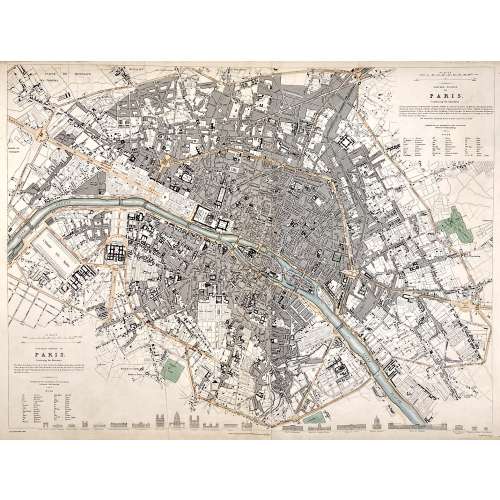 Top right: EASTERN DIVISION OF | PARIS. | Containing the Quartiers | {5 lines in italic} | Published under the Superintendence of the Society for the | Diffusion of Useful Knowledge || Bottom left: WESTERN DIVISION OF | PARIS. | Containing the Quartiers | {4 lines in italic} | Published under the Superintendence of the Society for the | Diffusion of Useful Knowledge || Under the frame: Drawn by W. B. Clarke, Archt. […] London: Published by Chapman and Hall, 186, Strand. April 1st, 1834. [...] Engraved by J. Shury || Dimensions: Sheet: 40.8 x 57 cm; Image: 38.7 x 52.5 cm. Contributors: William Barnard Clarke (British, 1806 – 1865) – artist. John Shury (fl. c. 1814-1844) – engraver. Chapman and Hall (London) – publisher. Society for the Diffusion of Useful Knowledge (SDUK) (British firm, 1826 – 1846).
Top right: EASTERN DIVISION OF | PARIS. | Containing the Quartiers | {5 lines in italic} | Published under the Superintendence of the Society for the | Diffusion of Useful Knowledge || Bottom left: WESTERN DIVISION OF | PARIS. | Containing the Quartiers | {4 lines in italic} | Published under the Superintendence of the Society for the | Diffusion of Useful Knowledge || Under the frame: Drawn by W. B. Clarke, Archt. […] London: Published by Chapman and Hall, 186, Strand. April 1st, 1834. [...] Engraved by J. Shury || Dimensions: Sheet: 40.8 x 57 cm; Image: 38.7 x 52.5 cm. Contributors: William Barnard Clarke (British, 1806 – 1865) – artist. John Shury (fl. c. 1814-1844) – engraver. Chapman and Hall (London) – publisher. Society for the Diffusion of Useful Knowledge (SDUK) (British firm, 1826 – 1846). -
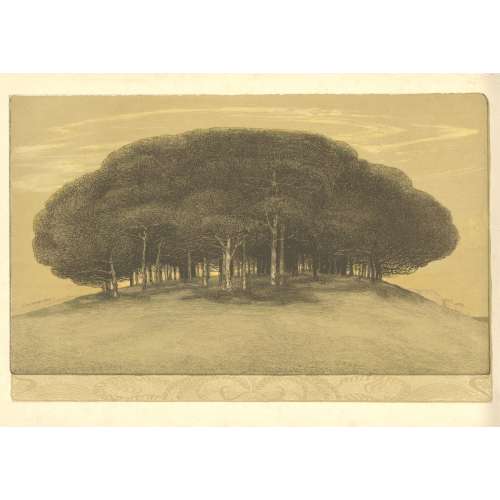 Colour (tone) lithography, image 268 x 410 mm, sheet 317 x 470 mm; signed on bottom-left of the image “Pelikan 1905”, and pencil ms inscription: E. Pelikan to the lower-right corner of the sheet. Contributor: Emilie Mediz-Pelikan (Austrian, 1861 – 1908) – artist. Seller's description: Austrian-German painter and graphic artist. Emilie Mediz-Pelikan was born in Vöcklabruck in 1861. She studied at the Vienna Academy and followed her teacher Albert Zimmermann to Salzburg and in 1885 to Munich. In 1891 she married the painter and graphic artist Karl Mediz (1868 - 1945), with whom she lived in Vienna and from 1894 in Dresden. She was in contact with the Dachau Artists' Colony and went on study trips to Paris, Belgium, Hungary and Italy. In the Dachau artists' colony she was friends with Adolf Hölzel and Fritz von Uhde. In 1889 and 1890 she spent time in Paris and in the Belgian artists' colony Knokke. In 1898 she was represented at the first art exhibition of the Vienna Secession, and in 1901 at the International Art Exhibition in Dresden. In 1903 she and her husband had a group exhibition, at the Hagenbund in Vienna. In 1904, she showed graphic works at the Dresden royal court art dealer Richter, and in 1905 and 1906 she exhibited at the Berlin Künstlerhaus. It was not until around 1900 that she achieved her artistic breakthrough with her landscape paintings. Since the estate of the artist, who died prematurely in Dresden in 1908, was lost in the former GDR until the 1980s, it was quite late that the artist was rediscovered and revalued both in Austrian art history and on the art market. In 1986, the first major exhibitions took place at the Upper Austrian State Museum and the University of Applied Arts in Vienna, followed by numerous smaller exhibitions in private galleries in Vienna, Linz and Munich. The artist received recognition during her lifetime from numerous prominent fellow painters as well as from the art critic Ludwig Hevesi. Together with Tina Blau, Herbert Boeckl, Marie Egner, Theodor von Hörmann, Franz Jaschke, Eugen Jettel, Ludwig Heinrich Jungnickel, Rudolf Junk, Gustav Klimt, Oskar Kokoschka, Johann Victor Krämer, Heinrich Kühn, Carl Moll, Rudolf Quittner, Rudolf Ribarz, Emil Jakob Schindler, Max Suppantschitsch, Max Weiler, Olga Wisinger-Florian and Alfred Zoff, she was a protagonist of the reception of Impressionism in Austria. This style went down in Austrian art history under the term "Stimmungsimpressionismus".
Colour (tone) lithography, image 268 x 410 mm, sheet 317 x 470 mm; signed on bottom-left of the image “Pelikan 1905”, and pencil ms inscription: E. Pelikan to the lower-right corner of the sheet. Contributor: Emilie Mediz-Pelikan (Austrian, 1861 – 1908) – artist. Seller's description: Austrian-German painter and graphic artist. Emilie Mediz-Pelikan was born in Vöcklabruck in 1861. She studied at the Vienna Academy and followed her teacher Albert Zimmermann to Salzburg and in 1885 to Munich. In 1891 she married the painter and graphic artist Karl Mediz (1868 - 1945), with whom she lived in Vienna and from 1894 in Dresden. She was in contact with the Dachau Artists' Colony and went on study trips to Paris, Belgium, Hungary and Italy. In the Dachau artists' colony she was friends with Adolf Hölzel and Fritz von Uhde. In 1889 and 1890 she spent time in Paris and in the Belgian artists' colony Knokke. In 1898 she was represented at the first art exhibition of the Vienna Secession, and in 1901 at the International Art Exhibition in Dresden. In 1903 she and her husband had a group exhibition, at the Hagenbund in Vienna. In 1904, she showed graphic works at the Dresden royal court art dealer Richter, and in 1905 and 1906 she exhibited at the Berlin Künstlerhaus. It was not until around 1900 that she achieved her artistic breakthrough with her landscape paintings. Since the estate of the artist, who died prematurely in Dresden in 1908, was lost in the former GDR until the 1980s, it was quite late that the artist was rediscovered and revalued both in Austrian art history and on the art market. In 1986, the first major exhibitions took place at the Upper Austrian State Museum and the University of Applied Arts in Vienna, followed by numerous smaller exhibitions in private galleries in Vienna, Linz and Munich. The artist received recognition during her lifetime from numerous prominent fellow painters as well as from the art critic Ludwig Hevesi. Together with Tina Blau, Herbert Boeckl, Marie Egner, Theodor von Hörmann, Franz Jaschke, Eugen Jettel, Ludwig Heinrich Jungnickel, Rudolf Junk, Gustav Klimt, Oskar Kokoschka, Johann Victor Krämer, Heinrich Kühn, Carl Moll, Rudolf Quittner, Rudolf Ribarz, Emil Jakob Schindler, Max Suppantschitsch, Max Weiler, Olga Wisinger-Florian and Alfred Zoff, she was a protagonist of the reception of Impressionism in Austria. This style went down in Austrian art history under the term "Stimmungsimpressionismus". -
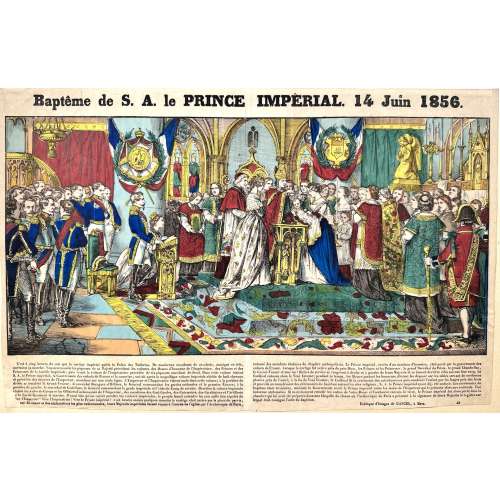 Hand-coloured woodcut on wove paper, 610 x 390 mm; black ink stamp “5207” to reverse, attached to a larger sheet of thick paper with a red ink stamp: “COLLECTION JEAN-CLAUD LACHNITT | REPRODUCTION INTERDIT”. Top: Baptême de S. A. le PRINCE IMPÉRIAL. 14 Juin 1856; image of baptism of Prince-Impérial; two-column text with a small loss in the lower left corner (C'est à cinq heures du soir que le cortège impérial quitta le Palais des Tuileries. De nombreux escadrons de cavalerie, musique en tête ouvraient la marche. ...); bottom under the text: "Fabrique d'Images de GANGEL, à Metz." — "49".
Hand-coloured woodcut on wove paper, 610 x 390 mm; black ink stamp “5207” to reverse, attached to a larger sheet of thick paper with a red ink stamp: “COLLECTION JEAN-CLAUD LACHNITT | REPRODUCTION INTERDIT”. Top: Baptême de S. A. le PRINCE IMPÉRIAL. 14 Juin 1856; image of baptism of Prince-Impérial; two-column text with a small loss in the lower left corner (C'est à cinq heures du soir que le cortège impérial quitta le Palais des Tuileries. De nombreux escadrons de cavalerie, musique en tête ouvraient la marche. ...); bottom under the text: "Fabrique d'Images de GANGEL, à Metz." — "49".


